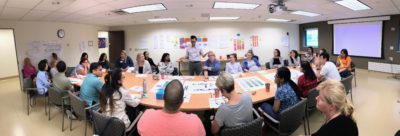By Yeena Peng
In mathematics it’s called the chaos theory: a very small change may make the system behave completely differently (hopefully for the better).
 But at Markham Stouffville Hospital (MSH) it is called, myCTE (my Care, my Team, my Experience). A new collaborative care model introduced last year that modified the way we deliver care to our patients, by making little changes that lead to big impact.
But at Markham Stouffville Hospital (MSH) it is called, myCTE (my Care, my Team, my Experience). A new collaborative care model introduced last year that modified the way we deliver care to our patients, by making little changes that lead to big impact.
The collaborative care model is not new; along with the countless amount of literature on the topic hospitals have been implementing various aspects of the model into care for some time now. But what is, is MSH’s back to basics approach to developing, testing, executing and refining our unique model of care incorporating the idea that little changes make big things happen.
myCTE was developed with the specific needs of the Markham Stouffville Hospital and community, in mind. It was developed with input from patients and caregivers – over 67 patients and family members were interviewed, and staff members from across disciplines in the hospital – total of 75 staff were interviewed, physicians, allied health, nurses, porters, etc. And the core development team comprised predominantly of frontline staff, sharing their perspectives.
The focus of MSH’s care delivery model supports patient and family centred care, promotes leading practices and is interprofessional in nature. By implementing this model MSH hoped to improve patient and family experience, empower patients with knowledge of their care received to date and promote proactive measurement, issues management, and ideas generation among staff.
The core components of myCTE include:
- Unit huddles: Units huddle daily to learn about what they need to know for the day.
- Team-based care: Nursing staff are now part of a team of three nurses responsible for 15 or so patients rather than one nurse to five patients, each sharing responsibility and information about all 15 patients.
- Bedside handover: Handover is done at the patient bedside rather than in nursing station, so the patient is included in the transfer of care and involved in their care planning.
- Post discharge phone calls: Follow-up with patients once they have left the hospital, part of the continuum of care.
- Hourly 5P rounds: Patients are visited by a nurse each hour to ensure their needs are met and communicated with regularly. The five P’s stand for: pain, personal hygiene, position, personal belongings and pump.
- Communication boards: Information on boards for staff and patients that include dietary information, goals, daily activity, personal information and preferences to allow for better two-way communication.
- Patient and family guidebook: provided to all patients and families with detailed information about the hospital, their stay in the hospital, etc., making it easily accessible.
“It’s not about epic solutions or solving massive problems overnight. This model of care is about building momentum through incremental change,” says Michelle Samm, Director of Patient Experience at MSH. “It’s about bringing a team together in a new and different way, ensuring patients/families are contributors in their plan of care. It’s about improving communications both ways for patients/families and staff.”
For example, by the introducing the team-based care approach, it eliminates the ‘I’m not sure, let me go find your nurse’ response. Patients can feel confident that staff are knowledgeable about their condition and can answer their questions without having to wait. Nobody likes, being told in a restaurant to wait until I find your waiter before I can help you. And patients feel the same, when they ask questions, they want to know that staff – no matter who they ask – can help them.
“We are making small improvements which may seem trivial to the lay person, but monumental to patient,” says Samm. “It’s showing our patients that we are making changes, visible changes and are headed in the right direction. It’s an ongoing process.”
Since implementation started in 2016, myCTE has been rolled out in 50 per cent of the hospital in the medicine and surgical units. The hospital expects 100 per cent adoption by 2018.
Not only has the program vastly improved the patient experience, it has also had a positive impact on staff as well. Staff are now armed with knowledge, spend more time with patients and complete a fuller scope of practice within all disciplines.
“I’ve noticed since implementing myCTE my team better understand how the entire unit works. Work is no longer siloed,” says Sheila Hogan, Patient Care Manager, Surgical Program at MSH. “With the implementation of myCTE there is more accountability. In our department, now any care provider in any discipline (e.g., personal support worker) can chart directly into the electronic medical record.”
myCTE was and continues to be a shift in how MSH staff work together to deliver excellent patient care. The goal of myCTE is constant improvement, incremental changes that lead to greater impact on the overall patient experience.
Yeena Peng is the Senior Corporate Communications Specialist at Markham Stouffville Hospital.


